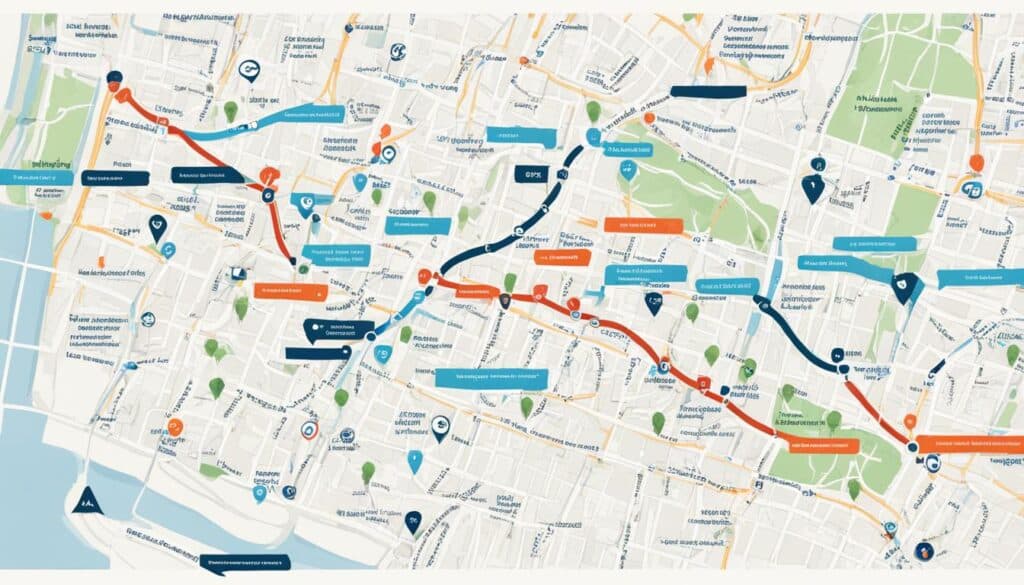Want to attract more visitors to your website? Learn the secrets with our guide on how to increase website traffic. The digital world is packed with competitors. To stand out, you must know the right moves. We offer you tips and tricks to draw more people—without spending much. This post is perfect for bloggers wanting more readers or start-ups looking to grow online.

Key Takeaways
- Discover cost-effective ways to increase website traffic.
- Learn how crafting compelling content is pivotal for attracting visitors.
- Gain insights into SEO practices that elevate your site’s search visibility.
- Find out how social media can serve as a potent traffic catalyst.
- Explore the role of analytics in fine-tuning your traffic-generation tactics.
Understanding the Importance of Website Traffic Growth
The era of digital success spins around website traffic. Knowing about website traffic tips and ways to get more website traffic is key for any online entrepreneur or brand. After all, website traffic isn’t simply numbers. It’s the very heartbeat of digital businesses, filled with chances for growth and connection.
More traffic means big benefits for businesses. It directly links to more sales and boosts brand recognition. A rise in visitors opens up new ways to make money and form partnerships.
Achieving these goals needs a plan that fits how people consume content and what they expect. Let’s explore the key parts of growing traffic that lead to a successful online presence.
- Higher Conversion Potential: More viewers means more potential customers. Each visit is a chance to show why your offer is worth it and turn interest into sales.
- Enhanced Search Engine Rankings: Search engines Ranking like sites with lots of traffic. This relevance boosts your visibility, leading to more organic growth.
- Expanded Brand Visibility: High traffic increases your brand’s presence, making a lasting mark in the digital world.
Let’s visually explore website growth’s impact:
| Aspect of Growth | Impact on Business |
|---|---|
| Brand Authority | Makes your brand more trustworthy and credible to your audience. |
| Market Reach | Access to a wider audience for greater market reach. |
| Retailer Confidence | Encourages more retailers and affiliates to partner with you. |
| Ad Revenue Potential | Increased traffic leads to more ad revenue. |
| User Data Accumulation | More visitors provide more data to improve your marketing. |
Growing your website traffic combines creative and analytical efforts. This means tweaking content, improving SEO, and focusing on a great user experience. While challenging, the rewards can be huge, offering new levels of online success.
Learning about
“ways to get more website traffic”
isn’t just skill—it’s an ongoing journey of adapting to the web’s changing landscape.
Content is King: Crafting High-Quality, Engaging Content
To captivate your audience and boost website traffic, quality content is key. This approach reflects the readers’ interests and needs. It builds strong connections and makes lasting impacts. Let’s explore how to engage your audience, create shareable content, and increase engagement with multimedia.
Identifying Your Audience’s Interests
Knowing your audience well is crucial for content success. Discover what they like by looking at their online activities, issues, and discussions. Surveys and feedback forms provide direct insights. Also, analyzing engagement on your current content offers deep understanding of their preferences.

Creating Shareworthy Articles and Blog Posts
The web is full of info, but only high-quality content shines. Great content mixes unique insights, useful tips, and an engaging hook. It must be relevant, valuable, and shareable on social platforms.
Using Multimedia Content to Increase Engagement
Text alone might not hold online viewers’ attention. Adding videos, podcasts, and infographics can boost engagement and website traffic. These formats prevent boredom and appeal to different user preferences, improving website experience.
| Content Type | Engagement Potential | Suitability for Audience |
|---|---|---|
| Informative Blog Posts | High | Readers seeking depth and detail |
| How-To Guides | Medium to High | Users looking for practical solutions |
| Engaging Videos | Very High | Visual learners and entertainment seekers |
| Interactive Infographics | Medium | Readers who prefer quick, digestible facts |
| Podcasts | Medium | Auditory learners and multitaskers |
In summary, creating content that captivates involves understanding your audience, being innovative in your formats, and delivering unique value. This sets you apart in the busy digital world.
SEO Essentials: Optimizing for Increased Organic Traffic
The digital world is always changing. It’s crucial to stay ahead in SEO to boost your site’s organic traffic. Before we dive into SEO strategies, it’s important to understand that each element has a specific role. This way, your website becomes more than just a space online. It turns into a go-to place for visitors wanting valuable content.
Keyword Research and Optimization
Starting any SEO strategy begins with keyword research and optimization. It’s about finding what potential customers are searching for. This lets you create content that meets their needs. By using keywords wisely, your content becomes more relevant and visible. This makes it easier for search engines to find and rank your pages. Good keyword research is key to drawing more visitors to your site.
Building Authority with Quality Backlinks
When it comes to SEO, the quality of backlinks matters a lot. Gaining backlinks from trusted sources is like getting a nod from the digital world. It shows your website’s authority and boosts its trustworthiness. Both search engines and users take notice. Backlinks prove your content’s value, making them vital for off-page SEO.
Improving On-Page SEO for Better Visibility
On-page SEO helps your website’s pages rank higher. It means tweaking both your content and HTML source code. You’ll work on title tags, headings, meta descriptions, and images. These changes improve your site’s visibility and search engine performance. They make it easier for visitors to find you online.
Now, let’s talk about title tags. Here’s how to structure a title tag for better SEO:
| Title Tag Component | Description | Example |
|---|---|---|
| Primary Keyword | Keyword you want the page to rank for | Organic Gardening |
| Secondary Keyword | Supporting keyword to boost relevance | Sustainable Farming Practices |
| Brand Name | Your company or website name for recognition | The Green Thumb |
| Title Length | Optimal character length for search engines to display without truncation | 60 Characters Maximum |
By careful refinement of these SEO parts, your site will rank better in search results. It becomes a light for those seeking your content. With keyword research, strong link-building, and on-page optimization, your site becomes a top resource in its niche. This is a key step to bringing in more website traffic.
Leveraging Social Media to Drive More Traffic to Website
Billions are active on social media, making platforms like Facebook, Twitter, and Instagram crucial for marketers. They aim to increase website traffic. Having a strategic presence is vital to resonate with your audience and boost website traffic.

To drive more traffic to website, use each platform’s unique strengths. Instagram, for example, uses visuals to connect personally with users. It can display products or show behind-the-scenes content.
- Facebook: Capitalize on its broad demographics to share informative blog posts and engage in community conversations.
- Twitter: Perfect for quick updates, industry news, and direct engagement through tweets and retweets.
- LinkedIn: Ideal for B2B marketers, offering opportunities to highlight thought leadership and connect with professionals.
- Pinterest: Drives inspiration and is particularly effective for lifestyle and decor brands with a predominantly female audience.
“Social media is not just an activity; it is an investment of valuable time and resources.”
Engaging content that promotes sharing will naturally increase website traffic. Multimedia like videos or live sessions greatly boosts engagement. Users often prefer these to text-only posts.
| Platform | Content Type | User Engagement | Traffic Potential |
|---|---|---|---|
| Video, Polls, Live Streaming | High | High | |
| Quick Updates, Hashtags, Images | Medium | Medium | |
| Stories, Reels, IGTV | Very High | High | |
| Articles, Company Updates, Professional Achievements | Medium | Medium to High | |
| Infographics, Step-by-Step Guides, Visual Inspiration | High | High |
Targeted advertising on these platforms can further boost website traffic. Ads need to be engaging and valuable to stand out.
Lastly, it’s crucial to monitor performance through analytics. You need to know what works for drive more traffic to website. This helps to continuously refine your strategies.
Maximizing Reach with Paid Advertising Campaigns
Today, paid advertising campaigns are key for growing your online presence. They get more people to see your website. Using PPC (Pay-Per-Click) and social media ads, businesses can reach the right people. This boosts brand visibility. It’s also crucial to keep improving your ad’s effectiveness for the best results.
Understanding PPC and Social Media Ads
With PPC advertising, you pay when someone clicks your ad. It brings more traffic to your site, different from organic visits. Google AdWords and Facebook Ads are top platforms for this. They allow detailed targeting, from where users are to what they like.
Targeting the Right Audience for Your Ads
Finding the right audience is a must for ad success. By analyzing data, you can pinpoint who will most likely connect with your brand. Using detailed audience data and customized ads helps target these individuals better.
Measuring and Adjusting Your Advertisements for Optimal Performance
It’s not enough to just start an ad campaign. For great advertising performance, review your ad results and tweak them based on data. A/B testing and checking metrics like click-through rate and cost per conversion are crucial. This approach helps your advertising budget work harder, increasing site traffic and conversions.
- Regularly check your ads to find what can be better.
- Tweak when you run ads to catch your audience when they’re most likely online.
- Track which ads and keywords get sales, then adjust your approach.
By getting good at these aspects of paid advertising, your business can make the most of PPC and social media ads. This will help every effort go towards increasing your site’s visitors and your overall online presence.
Analyzing Performance: How to Use Analytics to Guide Your Strategy
To boost your website’s performance, mastering analytics is key. First, start by setting up Google Analytics. It’s a powerful tool that collects a lot of data. This data helps you make smart decisions. Using analytics can help shape your growth strategy.
Setting Up Google Analytics for Insightful Data
Begin by setting up Google Analytics on your site. You’ll need to create an account, add your website, and put in a tracking code. Once it’s on, Google Analytics starts gathering valuable info. This info gives insights into how people use your site and where they come from.
Interpreting the Data and Recognizing Patterns
As data comes in, the key is to interpret the data for useful patterns. Look at things like bounce rate and how long people stay. This tells you what grabs attention and where to improve.
Making Data-Driven Decisions to Increase Traffic
Good analysis leads to data-driven decisions that boost your site’s traffic. Finding what engages users helps. Then, update your strategies to match what they like.
| Analytics Feature | Benefits | Actionable Insights |
|---|---|---|
| User Demographics | Understanding your audience’s composition. | Customize content to match user interests and increase relevance. |
| Acquisition Channels | Identifying how users find your website. | Focus resources on the most effective channels for traffic acquisition. |
| Behavior Flow | Visualize the path users take through your site. | Optimize user experience to encourage continued engagement and reduce drop-offs. |
| Conversion Rates | Measuring the percentage of users who take desired actions. | Enhance the features or content that drive conversions; A/B test to find the best performers. |
Analytics is more than collecting data. It’s about turning numbers into stories. Understand what your users do on your site. Then, create experiences that draw them in and keep them engaged. Keep tweaking your site. This ensures it stays lively and encourages growth.
How to Increase Website Traffic: Proven Tactics and Innovations
To stand out online, it’s crucial to use proven methods and new ideas to increase website traffic. This involves knowing and applying the latest digital marketing trends, offering a personalized experience, and collaborating with influencers. Let’s delve into these areas to see how they can enhance your web presence and draw more viewers.
Employing the Latest Digital Marketing Trends
Being up-to-date with digital marketing trends helps you outshine the competition. You might adopt new technologies, dive into data analytics, or explore fresh social media platforms. These actions not only foster creativity but can also lead to a big increase in website visitors.
Integrating Personalization to Enhance User Experience
Personalization is key to a great user experience. When you customize content, offers, and interactions for each visitor, you build stronger relationships. This approach keeps people on your site longer, boosting both traffic and conversions.
Collaborating with Influencers to Expand Your Reach
Working with collaborating with influencers opens up new ways to attract site visitors. Influencers with big followings in your field can expose your brand to both broad and specific audiences. This often leads to a significant increase in website traffic.
| Strategy | Benefits | Example |
|---|---|---|
| Digital Marketing Trends | Innovative edge, Adaptation to market changes, Increased engagement | Interactive chatbots, VR/AR experiences |
| Personalization | Enhanced user experience, Improved customer loyalty, Higher conversion rates | Personalized email marketing, Product recommendations |
| Influencer Collaboration | Access to new audiences, Authentic marketing, Boosted credibility | Sponsored content, Social media takeovers |
Conclusion
Boosting your website’s traffic is key in the fast-paced world of digital marketing. We’ve shared many tips and tricks to help increase your site’s visibility and attract more visitors. From creating engaging content to optimizing for search engines, and using social media and paid ads, these strategies can make a big difference.
Increasing website traffic is an ongoing process. It involves constantly checking and improving your tactics. Tools like Google Analytics help you understand your audience better. This lets you make smart choices based on data. Remember, digital marketing changes quickly. You need to stay flexible, keep up with trends, and always look to improve.
This guide has given you the tools to not just draw people to your site, but keep them coming back. With continuous effort and a focus on quality, your website can reach new heights. So, use these insights, tailor them to your brand, and see your website traffic grow.
FAQ
1. How can I increase website traffic?
To increase website traffic, try these steps. Start with high-quality, engaging content. Make sure your site is search engine friendly.
Use social media, run ads, and look at data to improve your strategy. These actions can drive more traffic effectively.
2. How can I boost blog traffic?
For more blog visitors, create content that people find useful and interesting. Use the right keywords for better search engine ranking.
Promote your blog on social media, guest post, and work with influencers. Also, ads and data analysis can help grow traffic.
3. What are some tips for increasing organic website traffic?
To get more organic traffic, optimize your site for search engines. Do keyword research and use those keywords well.
Get backlinks from trusted sites. Improve meta tags and title tags. Create content that others will want to share on social media.
4. How can I drive more traffic to my website?
Leverage social media with great posts, ads, and audience interaction. Optimizing your site for search engines is also key.
Focus on keywords, backlinks, and on-page SEO. Running ads and using data can refine your effort to attract more visitors.